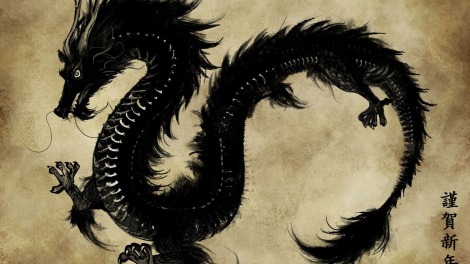
Oolong literally means black dragon in Chinese. The names comes from the original style of Oolong, in which the leaves are tall, long and curly.
Tea Basics – The many subdivisions of Oolong Tea
Oolong tea is basically a tea that has been partially oxidized, as opposed to Green/White tea which are almost not oxidized at all and Black Tea which is fully oxidized. Typically it is said that Oolongs are between 8% to 85% oxidized.
I would say that Oolong is the category of tea that is the broader taste wise. With other types of teas most of the time you can recognize a common taste or family of taste that is pervasive to all teas in the category. With Oolongs, the taste range is much broader, they can taste milky, crisp, roatsy, floral… and who knows maybe other flavors even!
As a disclaimer, I used the wikipedia page on Oolongs https://en.wikipedia.org/wiki/Oolong for some of the information in this post since it was very well written.
So here are the main subcategories you will find in the vast world of Oolong Tea.
Rolled or twisted
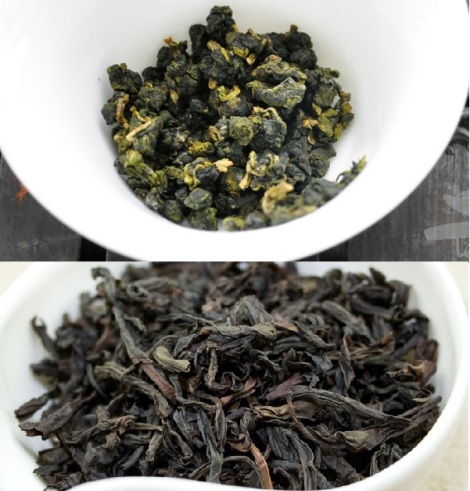
On top a green rolled Oolong and on the bottom a twisted roasted Wuyi Yancha Oolong.
The first thing you will notice is that visually the shape of the leaves will be different. Oolong tea leaves are either rolled into little balls or twisted into long think stick like shape.
Twisted Oolongs are very fluffy and voluminous. So if you are filling your brewing vessel by feel you will want to fill it about half way to 2/3.
Rolled Oolongs are obviously much more compact. Some are more tightly rolled than others, and you will notice that the stem is more visible with some of them as well (in China they remove the stem during the processing while in Taiwan they typically do not remove it.)
Origin
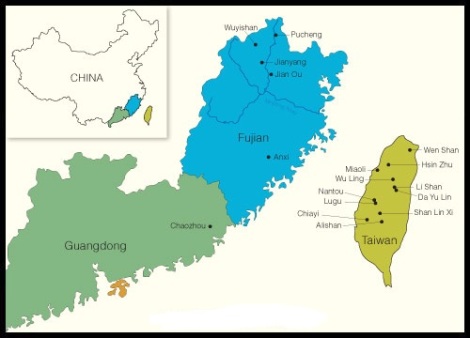
China
China is where Oolong originated. There are basically two regions that produce Oolong in China, Fujian and Guangdong province.
Fujian
Fujian is the province where Oolong is thought to have been created. Usually teas from Fujian are called either Wuyi (North Fujian) or Anxi (South Fujian) Oolongs.
Wuyi
In North Fujian they produce the darker, more oxidized, twisted and roasted Oolongs. Sometimes you will also hear their teas being called Wuyi Yancha. Wuyi is the name of a mountain range in North Fujian and Yancha means rock or cliff tea. There are a number of famous Oolongs that are Wuyi Yanchas:
- Da Hong Pao (大红袍) : Big Red Robe in Chinese.
- Shui Jin Gui (水金亀) : Gold Turtle in Chinese.
- Tie Luohan (鉄羅漢) : Iron Arhat in Chinese.
- Bai Ji Guan (白鸡冠) : White Comb in Chinese.
- Rou Gui (肉桂) : Cassia in Chinese, a dark tea with a spicy aroma.
Anxi
Tea in South Fujian is grown in Anxi county, so often you will also hear about Anxi Oolong. The most famous tea from that region is Tie Kuan Yin, which is often translated as “Iron Goddess of Mercy”.
Actually, Kuan Yin is not really a goddess in the western connotation of the word. Kuan Yin is the Chinese name of the Bodhisattva of compassion, Avalokiteshvara. A Bodhisattva is someone who, motivated by great compassion, has generated bodhicitta, which is a spontaneous wish to attain Buddhahood for the benefit of all beings. So it is not a goddess in the western or greek/roman sense of the word. A Bodhisattva is someone who has developed a far reaching and unshakable compassion and works tirelessly for the benefit of others.
Tie Kuan Yin is a rolled Oolong that in most usually a jade or green Oolong, meaning it is not much oxidized. It’s also possible to find roasted and/or aged Tie Kuan Yin.
Guangdong
Guangdong is a Chinese province that is located to the south west of Fujian. It is right next to Hong Kong and Macau. Guangdong is famous for their Single Bush or Dan Cong (单枞) Oolongs.
Dan Congs are a family of stripe-style oolong teas. The doppelganger of teas, Dancong teas are noted for their ability to naturally imitate the flavors and fragrances of various flowers and fruits, such as orange blossom, orchid, grapefruit, almond, ginger flower, etc.
The name dan cong originally meant phoenix teas all picked from one tree. In recent times though it has become a generic term for all Phoenix Mountain oolongs. True dan congs are still being produced, but they are extremely high quality and almost impossible to get in western markets.
Here are some of the most known Dancong or Phoenix Oolongs along with their translation:
- Yu Lan Xiang (玉蘭香) : Magnolia Flower Fragrance
- Xing Ren Xiang (杏仁香) : Almond Fragrance
- Zhi Lan Xiang (芝蘭香) : Orchid Fragrance
- Po Tou Xiang (姜花香) : Ginger Flower Fragrance
- Huang Zhi Xiang (黄枝香) : Orange Blossom Fragrance
- You Hua Xiang (柚花香) : Pomelo Flower Fragrance
- Mi Lan Xiang (米蘭香) : Honey Orchid Fragrance
- Rou Gui Xiang (肉桂桂香) : Cinnamon Fragrance
- Gui Hua Xiang (桂花香) : Osmanthus Fragrance
Taiwan
Tea cultivation began in Taiwan in the 18th century. Since then, many of the teas which are grown in Fujian province have also been grown in Taiwan. Since the 1970s, the tea industry in Taiwan has expanded at a rapid rate, in line with the rest of Taiwan’s economy. Due to high domestic demand and a strong tea culture, most Taiwanese tea is bought and consumed by the Taiwanese.
As the weather in Taiwan is highly variable, tea quality may differ from season to season. Although the island is not particularly large, it is geographically varied, with high, steep mountains rising abruptly from low-lying coastal plains. The different weather patterns, temperatures, altitudes, and soil ultimately result in differences in appearance, aroma, and flavour of the tea grown in Taiwan. In some mountainous areas, teas have been cultivated at ever higher elevations to produce a unique sweet taste that fetches a premium price. Here are the most common types of Taiwanese Oolongs.
- Dong Ding, Dongding (凍頂) : The name means Frozen Summit or Ice Peak. Dong Ding is a mountain in Nantou County, Central Taiwan. This is a tightly rolled tea with a light, distinctive fragrance.
- Oriental Beauty, Dongfang Meiren (東方美人茶) : The name means Oriental Beauty. Also known as White Tip Oolong, Bai Hao Oolong, or Braggart’s tea. This tea is tippy (the leaves frequently have white or golden tips), with natural fruity aromas, a bright red appearance, and a sweet taste.
- Alishan oolong, Alishan (阿里山茶) : Grown in the Alishan area of Chiayi County, this tea has large rolled leaves that have a purple-green appearance when dry. It is grown at an elevation of 1,000 to 1,400 metres. There is only a short period during the growing season when the sun is strong, which results in a sweeter and less astringent brew. It produces a golden yellow liquor which has a unique fruity aroma.[6] Alishan oolong is also referred to as Alishan High Mountain Tea or 阿里山高山茶 Ālǐshān gāoshānchá.
- Lishan oolong, Lishan (梨山) : Grown in the north-central region of Taiwan, this tea is very similar in appearance to Alishan teas, and is often considered to be one of the best teas from Taiwan. It is grown at an elevation above 1,000 metres, with Dayuling, Lishan, and Fusou being the best known regions and teas of Lishan. It is often grown on the extremely rare Taiwanese Mango, a sub-species of the tropical mango tree. Its thin, sturdy branches support the tea vines well and provide good sun exposure.
- Pouchong, (Baozhong) (包種茶) : Also romanized as Bāozhǒng, the lightest and most floral oolong,[citation needed] with unrolled leaves of a light green to brown color. Originally grown in Fujian it is now widely cultivated and produced in Pinglin Township near Taipei, Taiwan.
- Ruan Zhi, (Ruan Zhi) (軟枝) : This is a light variety of oolong tea. The tea is also known as Qingxin and as # 17. It originates from Anxi in Fujian province, China.
- Jin Xuan, (Jin Xuan) (金萱) : This is a variety of oolong tea developed in 1980. The tea is also known as “Milk Oolong” (Nai Xiang) because of its creamy, smooth, and easy taste. Traditional milk oolongs have no actual milk in them, but some companies are adding things like milk powder or steaming the leaves over milk to make a counterfeit. It originates from Taiwan.
Something to note also is that in many cases the names of Taiwanese Oolongs simply reflect the mountain where they were grown. Usually the higher the mountain, the more expensive and premium the tea is, although that second point is often the subject of debate. Tea plants cultivated at a higher altitude have to work harder to grow, which is thought to give a richer taste to the tea. One thing that is certain is that there is definitely a taste profile that is particular to high mountain Oolongs.
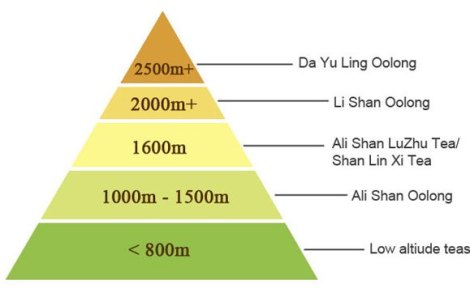
Da Yu Ling (about 2500 meters) is the highest mountain where tea is grown, followed by Lishan (up to 2200 meters). But not all tea is cultivated on the highest part of the mountain, so it is possible to get a Lishan tea for example that is of a lower altitude. Most Taiwan teas are green Oolongs that have been only lightly oxidized.
Newcomers in the Oolong game
Recently there have been some Oolongs that are produced in Nepal and Hawai mostly. These are pretty new so they are still a niche product and not really categorized yet. If you search hard enough on the internet though you will be able to find online vendors who sell them.
Green or roasted
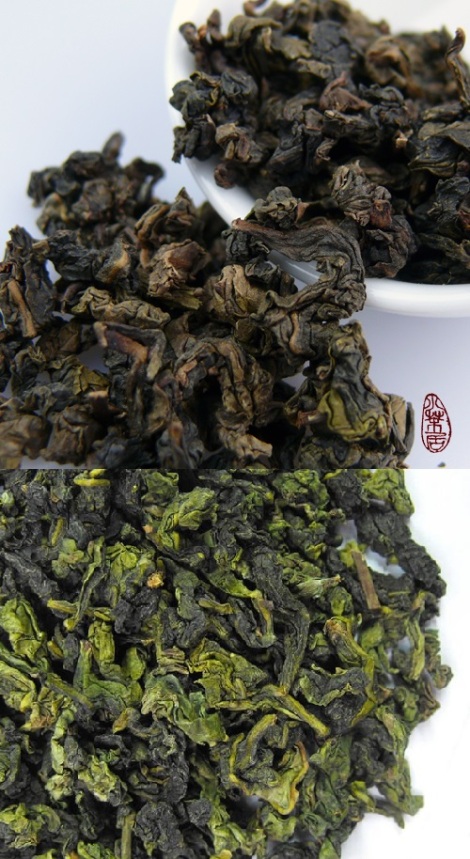
Both are Tie Kuan Yin Oolongs but the top one is roasted while the bottom one isn’t.
Lightly oxidized or green Oolongs
Most times when Oolongs are not roasted it means that they are lightly oxidized, although that is not always the case. Lightly oxidized Oolongs will have a greener and sublter taste profile. If you buy a green Oolong most likely it should be consumed within the next few following months, similarly to green teas. If you keep your green Oolong for too long the taste will fade and the tea will become a shadow of its former self.
Most Taiwanese teas are green Oolongs and the famous Tie Kuan Yin is a green Oolong as well.
Roasted Oolongs
Roasted Oolongs have a much more roasty charcoal taste. They can be lightly, medium or deeply roasted. When they are lightly roasted the dry leaves might appear dark but as you infuse them they will become greener. You will taste the roast much more during the first few infusions and then the taste profile will change. Wuyi and Dan Cong teas are pretty much all roasted, and there are roasted version of some of the most famous green Oolongs such as roasted Tie Kuan Yin or roasted versions of famous Taiwanese Oolongs. Typically Wuyis have a deeper roast than Dan Congs, but like everything else in tea that is not always the case.
If you ate at a Chinese restaurant or went to Dim Sum and were served a roasty tasting tea you most likely drank a (low quality) roasted Oolong. The roast makes the taste of these Oolongs much bolder than the taste profile of green Oolongs, so they are better suited to drink with food. Teas whose taste is more subtle tend to be overshadowed by the taste of food if consumed together.
Aging Oolongs
The roasting process allows Oolongs to keep “fresh” for much longer. Typically, a roasted Oolong with stay fresh or maintain its flavor for about 3 years. It is possible to age Oolongs by doing the initial roasting, then storing and re-roasting them periodically. So if you are drinking a 20 year old Oolong, it means it has probably been roasted about 6 to 7 times in total over that time period. There isn’t a huge market for aged Oolongs, but it isn’t that hard to find them either.
Some Oolong oddities
There are some teas which are sometimes called “bug bitten tea”. Basically Oriental Beauty (mentionned above) and Gui Fei are Oolongs that have been bitten by a type of bug, which creates a reaction that completely changes the taste of tea. I have reviewed a Gui Fei in one of my recent posts, so if you want more information on the subject please refer to this review.
